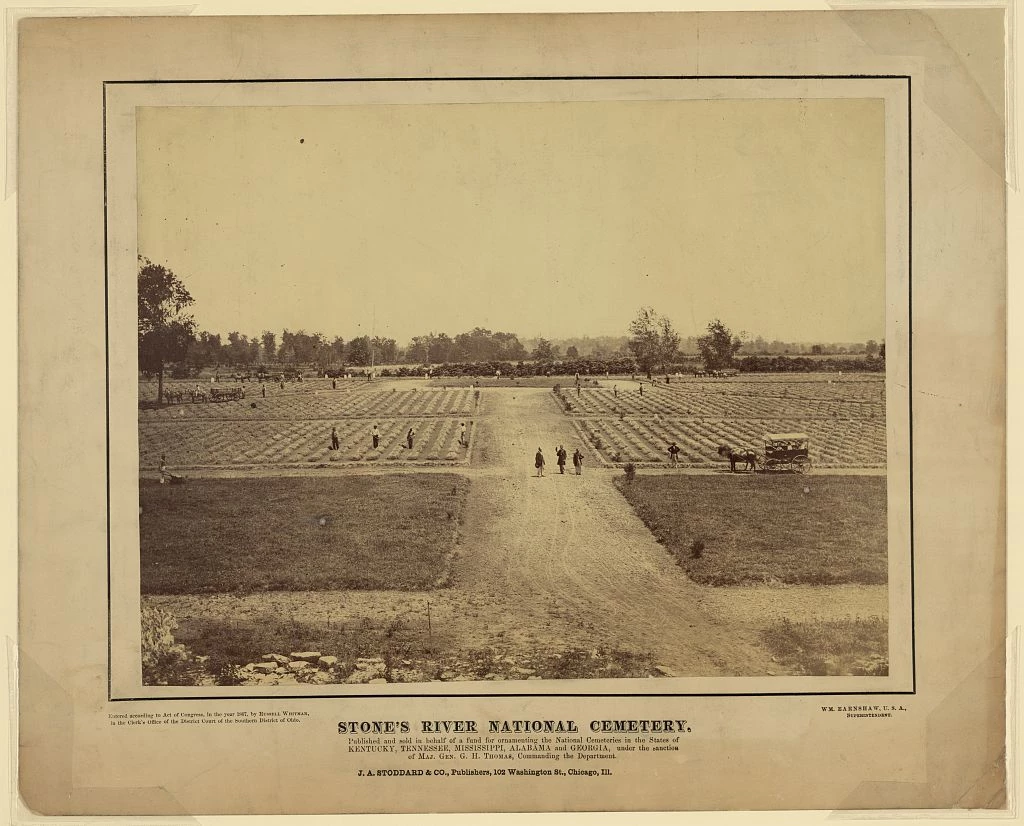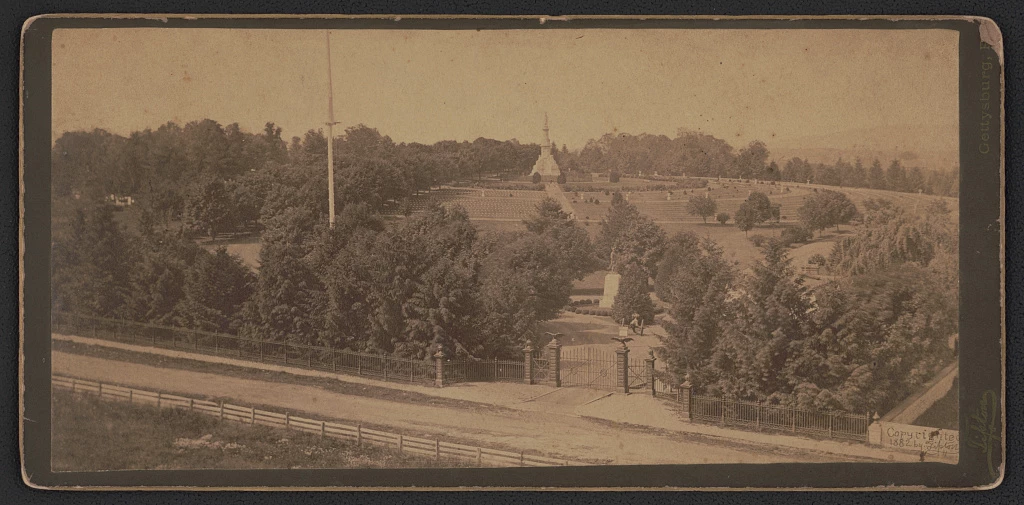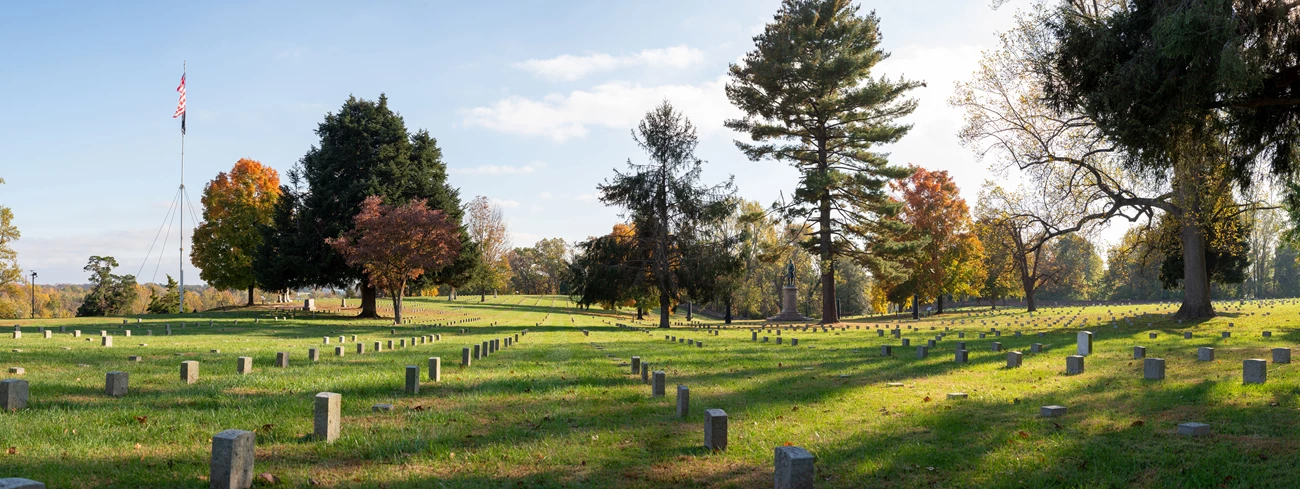Last updated: March 21, 2025
Article
History of National Cemeteries
From Necessity to Honor
The history of national cemeteries in the United States begins with the Civil War. The first national cemeteries were created at the start of the Civil War, in the early 1860s, to bury US soldiers from the war.
About a dozen national cemeteries and numerous soldiers' lots were established in 1862, more than a year after the war began with Confederate troops firing on Fort Sumter. By 1870, almost 300,000 Union soldiers and sailors lay buried in 73 national cemeteries. These cemeteries were first set aside for burial of those who died during the conflict, but by 1873, any US veteran of the Civil War could receive burial in a national cemetery.
Today, the nation has more than 175 national cemeteries, soldiers’ lots, government lots, and Confederate cemeteries. Three federal agencies manage them: the National Cemetery Administration of the Department of Veterans Affairs (VA); the Department of the Army of the Department of Defense; and the National Park Service of the Department of the Interior. Originally created to honor Union soldiers killed during the Civil War, national cemeteries have become national memorials to all United States veterans.
Changing Burial Practices
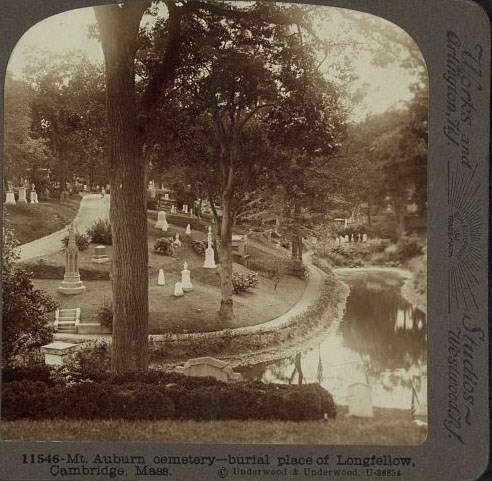
Underwood & Underwood, Library of Congress
The burial practices for soldiers and sailors in the United States evolved over time. Soldiers killed in the American Revolution and the War or 1812 were usually buried in churchyards or family cemeteries. As European American settlers moved westward across the continent, the U.S. Army established forts and post cemeteries for soldiers and family members.
At the same time, the growing urban population and concerns about sanitation caused many churches and cities to establish new cemeteries on the undeveloped outskirts of cities. The first of these rural cemeteries was Mount Auburn, created in 1831 outside of Boston. Mount Auburn was designed like a park, so that families could spend their leisure time with their deceased relatives.
At the beginning of 1861, neither the post cemeteries nor the rural cemeteries were prepared for the burial of ultimately more than 600,000 men who died during the Civil War. The nation needed new burial practices to deal with the changing realities of war. Weapon accuracy and fighting techniques led to more casualties than in previous wars; railroads and steamships carried soldiers to battles farther and farther from their homes; and disease caused a high percentage of the deaths on battlefields, in prisoner-of-war camps, and in hospitals.
Prior to the Civil War, burial of the war dead was the responsibility of the Army’s Office of the Quartermaster General, which also provided food, shelter, and supplies to the soldiers. This changed in September 1861, when the United States War Department issued General Orders No. 75, which designated US Army commanding officers responsible for burial of the dead from their units. This order presented many challenges. Fighting often killed many soldiers, including the commanding officer. Of the survivors, after a long and arduous battle, few could move bodies and digging graves due to fatigue, hunger, and injury.
In addition, materials and information for grave markers were often non-existent. Given that many battles occurred on farm fields, soldiers often received hasty burials in shallow graves where they fell. Commanding officers were also required to keep records of deceased soldiers and burial site locations. This proved difficult because few soldiers had any form of identification on them. Some soldiers pinned a piece of paper to their clothing with their name and address, but dog tags did not become standard issue until the 20th century. While some wealthy families paid to have their sons’ bodies sent home by train, the long distances and high costs made this impossible for most families. Stories of family members and friends searching for the body of a deceased soldier were common in the history of the Civil War.
The First National Cemeteries
In 1861, the Board of Governors of the Soldiers' Home in Washington, DC permitted the Army to bury soldiers who died in and around the capital city in a section of its cemetery, but this land quickly filled up. Faced with the growing number of military dead, the US Congress passed legislation in July of 1862, which among other actions, including pay, contracts, and rations, and authorized the US President to purchase land for the establishment of cemeteries for burial of those fighting on behalf of the United States.
The first cemeteries were established near key locations: battlefields, including Mill Springs National Cemetery in Nancy, Kentucky; hospitals, including Keokuk, Iowa; and other troop concentration points such as Alexandria, Virginia. By the end of the Civil War in spring 1865, there were approximately 30 national cemeteries and seven soldiers’ lots in private cemeteries. Despite this, many soldiers still were lying in farm fields due to hastily conducted wartime burials, often having their remains exposed over time.
National Cemetery Improvements and Developments
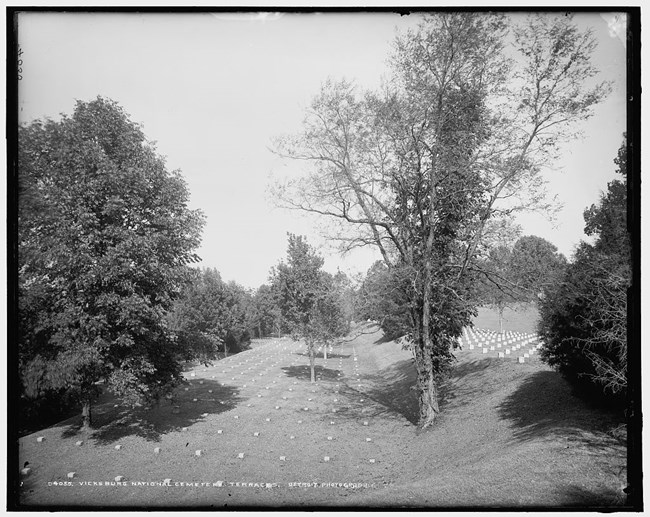
William Henry Jackson, published by Detroit Publishing Co. Library of Congress
By 1867, the growing concern about the conditions of these wartime interments led to a new effort to provide a proper burial for every US soldier and sailor who died during the war. The Office of the U.S. Quartermaster General established national cemeteries in central locations such as Memphis, Tennessee, where they assembled remains from around the region for burial. Among the reinterments were soldiers from the United States Colored Troops.
Also in 1867, the “Act to Establish and Protect National Cemeteries” required the Secretary of War to enclose every national cemetery with a stone or iron fence, to mark every gravesite with a headstone, appoint a superintendent to each cemetery, and construct a lodge for the superintendent to occupy. Despite these requirements, a permanent stone marker design was not adopted until 1873. Several years later, in 1879, Congress authorized the furnishing of headstones for the unmarked graves of veterans in private cemeteries.
In 1873, national cemetery interment eligibility expanded to include all Union veterans, as a final benefit of service to the country. Eligibility requirements for national cemeteries continued to expand in the 20th century to include most honorably discharged veterans, their spouses, and dependent children.
Confederate Burials
Confederate soldiers could not be buried in national cemeteries, nor were they afforded any benefits from the United States government for many decades after the end of the Civil War. When the reburial corps in the late 1860s found the remains of Confederate soldiers lying near those of US soldiers, they removed the US soldiers but left the Confederates’ bodies. Because identification of remains was difficult at best, some Confederate soldiers were unintentionally reburied in national cemeteries, taken for US soldiers. Confederate prisoners of war were often interred in “Confederate sections” within the national cemeteries.
Generally, within national cemeteries and at other cemeteries under the care of the federal government, Confederate graves were marked first with wooden headboards (as had been the case with the graves of US military) and later with marble markers with just the name of the soldier engraved on the stone, so that they were indistinguishable from civilians buried in the national cemeteries.
Private organizations, especially women’s organizations established in former Confederate states after the war, assumed responsibility for Confederate reburials. One of the more prominent groups was the Hollywood Memorial Association, which raised funds to move the bodies of Confederate soldiers from the battlefields of Gettysburg and Drewry’s Bluff to Hollywood Cemetery in Richmond, Virginia. The appearance of grave markers varied in these Confederate cemeteries depending on the preferences of the supervising organization.
The federal government first became involved in permanently marking Confederate graves in 1906. That year, Congress authorized the furnishing of headstones for Confederate soldiers who died in federal prisons and military hospitals in the Union states, and they were buried near their places of confinement.
The act also established the Commission for Marking Graves of Confederate Dead, who ensured that the graves of Confederate soldiers received markers. The design for these grave markers was to be more or less identical to that approved in 1901 for marking Confederate graves at Arlington National Cemetery. The headstone was the same size and material as those for US soldiers, except the top was pointed instead of rounded, and the US shield was omitted.
An Act of January 20, 1914 authorized the furnishing of headstones for the unmarked graves of both US and Confederate soldiers, sailors, and marines in national, post, city, town, and village cemeteries. This provision allowed graves of Confederate soldiers buried in national cemeteries in the South, such as Fort Smith and Little Rock National Cemeteries in Arkansas, to be marked with the distinctive Confederate-style headstone.
National Cemeteries Today
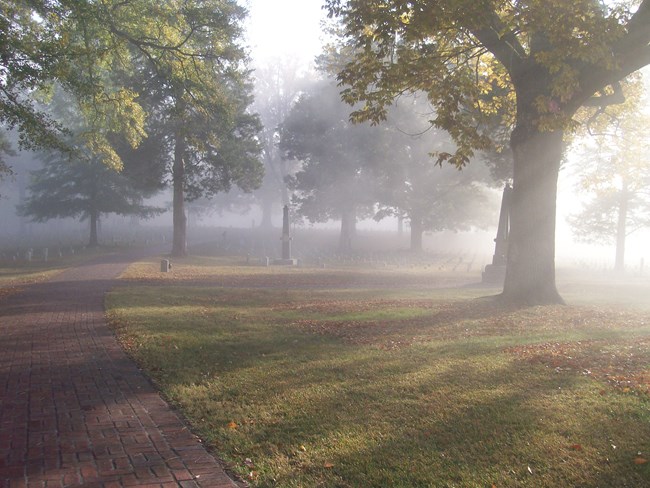
NPS / Mekow
Today, three federal agencies manage more than 170 national cemeteries. The Veterans Administration, precursor to the Department of Veterans Affairs (VA), originally had responsibility for 21 cemeteries, some of them associated with the National Home for Disabled Volunteer Soldiers. The VA National Cemetery Administration currently maintains 155 national cemeteries and 34 related soldiers’ lots transferred from the Department of the Army to the VA in 1973.
The Army retains control of two national cemeteries, Arlington National Cemetery in Arlington, Virginia, and Soldiers’ Home National Cemetery in Washington, D.C.
The National Park Service manages 14 national cemeteries, the majority of which the War Department transferred to the National Park Service in 1933 along with the adjacent national military parks.
The Department of Veterans Affairs continues to establish new cemeteries to provide burial benefits to veterans who served, as well as their families, as close to home as possible. All three agencies maintain the national cemeteries as memorials to honor those who served and sacrificed their lives for the United States.
This article is an adaptation of “From Necessity to Honor: The Evolution of National Cemeteries in the United States” written by Kerry Merrifield for the National Park Service Civil War Era National Cemeteries Discover Our Share Heritage Travel Itinerary.

